| Listing 1 - 10 of 131 | << page >> |
Sort by
|
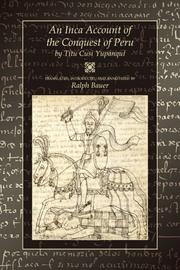
ISBN: 1607320460 1457110776 9781457110771 9781457109690 1457109697 9781607320463 087081821X 9780870818219 0870818074 9780870818073 Year: 2005 Publisher: Boulder, Colo. University Press of Colorado
Abstract | Keywords | Export | Availability | Bookmark
 Loading...
Loading...Choose an application
- Reference Manager
- EndNote
- RefWorks (Direct export to RefWorks)
Available in English for the first time, An Inca Account of the Conquest of Peru is a firsthand account of the Spanish invasion, narrated in 1570 by Diego de Castro Titu Cusi Yupanqui - the penultimate ruler of the Inca dynasty - to a Spanish missionary and transcribed by a mestizo assistant. The resulting hybrid document offers an Inca perspective on the Spanish conquest of Peru, filtered through the monk and his scribe. Titu Cusi tells of his father's maltreatment at the hands of the conquerors; his father's ensuing military campaigns, withdrawal, and murder; and his own succession as ruler
Book
ISBN: 0813059631 0813052556 9780813052557 9780813062914 0813062918 9780813059631 Year: 2016 Publisher: Gainesville
Abstract | Keywords | Export | Availability | Bookmark
 Loading...
Loading...Choose an application
- Reference Manager
- EndNote
- RefWorks (Direct export to RefWorks)
Alconini explores the interactions between the Inka and Amazonia, a large empire versus a less complex population. The book focuses on frontier archaeology and the socio-economic forces at play in the Inka empire's borders.
Indians of South America --- Incas --- History. --- Peru --- Indiens d'Amérique --- Histoire --- Pérou
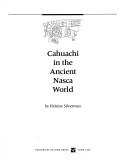
ISBN: 1587292238 9781587292231 0877454078 9780877454076 Year: 1993 Publisher: Iowa City : University of Iowa Press,
Abstract | Keywords | Export | Availability | Bookmark
 Loading...
Loading...Choose an application
- Reference Manager
- EndNote
- RefWorks (Direct export to RefWorks)
Ever since its scientific discovery, the great Nasca site of Cahuachi on the south coast of the Central Andes has captured the attention of archaeologists, art historians, and the general public. Until Helaine Silverman's fieldwork, however, ancient Nasca culture was seen as an archaeological construct devoid of societal context. Silverman's long-term, multistage research as published in this volume reconstructs Nasca society and contextualizes the traces of this brilliant civilization (ca. 200 B.C.-A.D. 600).Silverman shows that Cahuachi was much larger and more complex than port
Nazca culture. --- Nasca culture --- Indians of South America --- Antiquities --- Nazca (Peru) --- Cahuachi Site (Peru) --- Peru --- Nasca (Peru) --- Antiquities. --- Culture de Nazca --- Nazca (Pérou) --- Cahuachi (Pérou : Site archéologique) --- Antiquités
Book
ISBN: 9781607323174 9781607323181 1607323184 1607323176 Year: 2015 Publisher: Boulder
Abstract | Keywords | Export | Availability | Bookmark
 Loading...
Loading...Choose an application
- Reference Manager
- EndNote
- RefWorks (Direct export to RefWorks)
Indians of South America --- Huacas --- Indiens d'Amérique --- Antiquities --- Antiquities. --- Antiquités --- Andes --- Peru --- Pérou --- Huacas.
Book
ISBN: 9789004233850 9789004233874 9004233873 9004233857 Year: 2012 Volume: 3 Publisher: Boston Brill
Abstract | Keywords | Export | Availability | Bookmark
 Loading...
Loading...Choose an application
- Reference Manager
- EndNote
- RefWorks (Direct export to RefWorks)
The historical narratives of the Inca dynasty, known to us through Spanish records, present several discrepancies that scholarship has long attributed to the biases and agendas of colonial actors. Drawing on a redefinition of royal descent and a comparative literary analysis of primary sources, this book restores the pre-Hispanic voices embedded in the chronicles. It identifies two distinctive bodies of Inca oral traditions, each of which encloses a mutually conflicting representation of the past that, considered together, reproduces patterns of Cuzco’s moiety division. Building on this new insight, the author revisits dual representations in the cosmology and ritual calendar of the ruling elite. The result is a fresh contribution to ethnohistorical works that have explored native ways of constructing history.
Incas --- Inca cosmology --- Inca calendar --- Cosmologie inca --- Calendrier inca --- History --- Kings and rulers --- Histoire --- Rois et souverains --- Cuzco (Peru) --- Cuzco (Pérou) --- Cuzco (Pérou) --- Historiography. --- Kings and rulers.
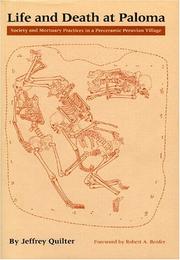
ISBN: 1587291983 9781587291982 9780877451945 087745194X 9781587293993 1587293994 Year: 1989 Publisher: Iowa City : University of Iowa Press,
Abstract | Keywords | Export | Availability | Bookmark
 Loading...
Loading...Choose an application
- Reference Manager
- EndNote
- RefWorks (Direct export to RefWorks)
Life and Death at Paloma, when published in 1989, was the first in-depth treatment of burials from a preagricultural South American village. It remains a valuable resource used by students and scholars of Andean archaeology. Jeffrey Quilter analyzes the life of Paloma's people during the transition from a hunting-gathering-fishing way of life to a more sedentary horticultural society and offers a study of preceramic Peruvian life through his analysis of this site's graves and their contents.
Indians of South America -- Funeral customs and rites -- Peru. --- Indians of South America -- Peru -- Antiquities. --- Paloma Site (Peru). --- Peru -- Antiquities. --- Indians of South America --- American aborigines --- American Indians --- Indigenous peoples --- Funeral customs and rites --- Antiquities. --- Ethnology --- Indiens d'Amérique --- Rites et cérémonies funéraires --- Antiquités --- Paloma Site (Peru) --- Peru --- Paloma (Pérou : Site archéologique) --- Pérou --- Antiquities
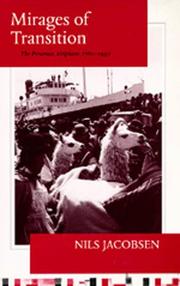
ISBN: 0520913914 0585129533 9780520913912 9780585129532 9780520082915 0520082915 9780520079380 0520079388 0520079388 0520082915 Year: 1993 Publisher: Berkeley University of California Press
Abstract | Keywords | Export | Availability | Bookmark
 Loading...
Loading...Choose an application
- Reference Manager
- EndNote
- RefWorks (Direct export to RefWorks)
This case study of the Peruvian altiplano, the vast high-altitude plains surrounding Lake Titicaca, combines economic and social analysis with cultural and institutional history. Nils Jacobsen challenges the prevailing view that the rural Andes underwent a successful transition to capitalism between the mid-nineteenth and early twentieth centuries. He argues that although the political, economic, and administrative structures of colonialism were gradually dismantled by the region's advancing market economy, colonial modes of constructing power and social identity have lingered on even to this day. The result of painstaking research in remote rural archives, some of them now made inaccessible by the Shining Path, Mirages of Transition will become the definitive work on the Peruvian highlands.
Economic History --- Business & Economics --- Azángaro (Peru : Province) --- Azangaro (Perou : Province) --- Azangaro (Pérou : Province) --- Economic conditions --- Social conditions --- Conditions économiques --- Conditions sociales --- Economic conditions. --- Social conditions. --- HISTORY / Latin America / General.
Book
ISBN: 9780199687695 0199687692 019151148X 0191804835 9780191511486 9780191804830 Year: 2014 Publisher: Oxford
Abstract | Keywords | Export | Availability | Bookmark
 Loading...
Loading...Choose an application
- Reference Manager
- EndNote
- RefWorks (Direct export to RefWorks)
Relics of the Past tells the story of antiquities collecting, antiquarianism, and archaeology in Peru and Chile in the second half of the nineteenth and the early twentieth century. While the role of foreign travellers and scholars dedicated to the study of South America's pre-Columbian past is well documented, historians have largely overlooked the knowledge gathered and the collections formed among collectors of antiquities, antiquaries, and archaeologists born or livingin South America during this period. The landed gentry, the clergy, and an urban bourgeoisie of doctors, engineers, and mil
Archaeology --- Collectors and collecting --- Antiquarians --- Archéologie --- Collectionneurs et collections --- Spécialistes d'histoire ancienne --- History --- History. --- Histoire --- Peru --- Chile --- Pérou --- Chili --- Antiquities. --- Antiquités --- Collectibles --- Collecting --- Collection and preservation --- Art --- Hobbyists --- E-books
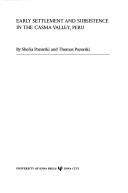
ISBN: 1587291940 9781587291944 0877451834 9780877451839 9780877451839 0877451834 9781587294624 Year: 1987 Publisher: Iowa City : University of Iowa Press,
Abstract | Keywords | Export | Availability | Bookmark
 Loading...
Loading...Choose an application
- Reference Manager
- EndNote
- RefWorks (Direct export to RefWorks)
The Casma Valley of Peru's north central coast contains the largest New World structure of its time period---2500 to 200 BC---as well as one of the densest concentrations of early sites. In this detailed and thought-provoking volume, Sheila and Thomas Pozorski date each major early site, assess this important valley's diet and subsistence changes through time, and begin to reconstruct the development of Casma Valley society.Fifteen sites are surveyed, including Pampa de las Llamas-Moxeke, the earliest planned city in the New World. The Pozorskis then synthesize their own fieldwork and previous
Casma River Valley (Peru) -- Antiquities. --- Indians of South America -- Peru -- Casma River Valley -- Antiquities. --- Indians of South America -- Peru -- Casma River Valley -- Economic conditions. --- Indians of South America --- Regions & Countries - Americas --- History & Archaeology --- Latin America --- American aborigines --- American Indians --- Indigenous peoples --- Antiquities --- Economic conditions --- Ethnology --- Excavations (Archaeology) --- Indiens d'Amérique --- Fouilles (Archéologie) --- Antiquities. --- Economic conditions. --- Antiquités --- Conditions économiques --- Casma River Valley (Peru) --- Peru --- Casma, Vallée de la (Pérou) --- Pérou --- Casma Valley (Peru)
Book
ISBN: 9781477311493 1477311491 1477313206 1477313214 Year: 2017 Publisher: Austin, [Texas] : University of Texas Press,
Abstract | Keywords | Export | Availability | Bookmark
 Loading...
Loading...Choose an application
- Reference Manager
- EndNote
- RefWorks (Direct export to RefWorks)
Huaca Prieta-one the world's best-known, yet least understood, early maritime mound sites-and other Preceramic sites on the north coast of Peru bear witness to the beginnings of civilization in the Americas. Across more than fourteen millennia of human occupation, the coalescence of maritime, agricultural, and pastoral economies in the north coast settlements set in motion long-term biological and cultural transformations that led to increased social complexity and food production, and later the emergence of preindustrial states and urbanism. These developments make Huaca Prieta a site of global importance in world archaeology. This landmark volume presents the findings of a major archaeological investigation carried out at Huaca Prieta, the nearby mound Paredones, and several Preceramic domestic sites in the lower Chicama Valley between 2006 and 2013 by an interdisciplinary team of more than fifty international specialists. The book's contributors report on and analyze the extensive material records from the sites, including data on the architecture and spatial patterns; floral, faunal, and lithic remains; textiles; basketry; and more. Using this rich data, they build new models of the social, economic, and ontological practices of these early peoples, who appear to have favored cooperation and living in harmony with the environment over the accumulation of power and the development of ruling elites. This discovery adds a crucial new dimension to our understanding of emergent social complexity, cosmology, and religion in the Neolithic period.
Excavations (Archaeology) --- Indians of South America --- Human ecology --- Fouilles (Archéologie) --- Indiens d'Amérique --- Ecologie humaine --- Antiquities. --- History --- Antiquités --- Histoire --- Huaca Prieta Site (Peru) --- Chicama River Valley (Peru) --- Huaca Prieta (Pérou : Site archéologique) --- Chicama, Vallée de la (Pérou) --- Civilization. --- Civilisation --- Archaeological expeditions --- Archaeological digs --- Archaeological excavations --- Digs (Archaeology) --- Excavation sites (Archaeology) --- Ruins --- Sites, Excavation (Archaeology) --- Archaeology --- Expeditions, Archaeological --- Chicama Site (Peru) --- Peru --- Antiquities
| Listing 1 - 10 of 131 | << page >> |
Sort by
|

 Search
Search Feedback
Feedback About UniCat
About UniCat  Help
Help News
News